Sneak Peek: 5th Annual Waste & Recycling Facility Fire Report

2021 is in the books, and I am putting the finishing touches on the “5th Annual Waste & Recycling Facility Fires Annual Report for the US and Canada.” This year’s report promises to be one for the ages as we officially experienced more reported fire incidents this year than we have since I began consolidating the data in 2016.
In lieu of providing January’s data, this month I will provide a sneak peek into the report. Click here to reserve your advanced copy of this year’s annual waste and recycling facility fires report.
Executive Summary
The Bad News: THERE IS AN INHERENT RISK OF FIRES IN THE WASTE AND RECYCLING INDUSTRY! I do not say that statement lightly. The problem is not going away. In fact, all the data in my report point toward the problem getting worse. What is causing this to happen? In a nutshell, traditional hazards combined with the onslaught of batteries in our waste and recycling streams, worsening heat across the globe and a myriad of other factors continue to make operating in this space more dangerous. Additionally, as the world seeks to become “greener,” more stress is being placed on our waste and recycling infrastructure. Hazards that used to get thrown and forgot in a landfill or illegally dumped in the wrong places are being handled correct but not without causing some negative effects on our infrastructure. So, in essence, more fires are a good problem to have but dangerous nonetheless.
The Good News: There are solutions to our fire problem. Many industries that have an inherent risk of fires in their operations have learned through education, operational best practices and investment in technology to safely operate within the constraints of their issues.
There are many great folks who work on educating the public about proper recycling, some of whom are highlighted in my report. I also believe that some of the costs of these fire hazards should be borne by the manufacturers as opposed to the operators, insurance companies and municipal fire departments. Due to the massive nature of these solutions, they take a ton of time and resources to really move the needle. Add to that the number of hazards that are increasing at a compounding scale, it’s clear we need to fight on parallel fronts.
What can the operators, technology providers and fire professionals do? NOT HAVE A MAJOR FIRE INCIDENT.
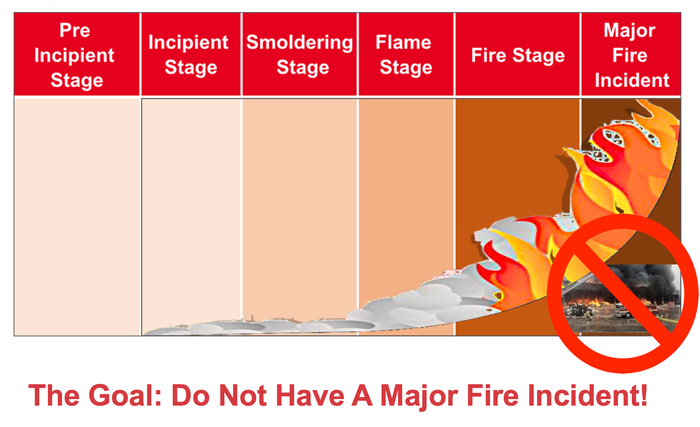
Fire is not the problem until it becomes the problem. Early on in my industry tenure, I kept hearing the same thing, “Fire grows in size and scope every X seconds/minutes.” Put whatever compounding factor in you want, but the reality is the earlier you catch a fire, the better chance you have at mitigating the risk to employees, fire professionals, operations and physical infrastructure.
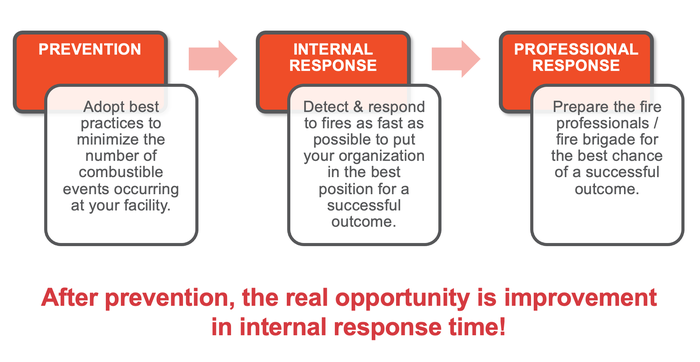
So, what does that mean in reality?
Prevention: It’s the operator’s job to follow best practices to minimize a fire.
Internal Response: Solutions like the Fire Rover that not only detect the fire early but eliminate the need for a response when the situation warrants and the ability to engage the fire professionals when needed.
Professional Response: Arming and equipping our fire professionals with the proper tools, training, techniques and education to successfully fight these types of fires hazards.
Successfully fighting fire problems on a long-term basis requires a combination of all parties working together in lockstep and ready to respond when and if the situation arises. Since no two fire incidences are the same, no two responses are the same, which is why we need a framework that allows for flexibility, quick thinking and proper actions to ensure if an operator has a fire incident that it is not “major” or “catastrophic.”
In 2021, my team at Fire Rover was responsible for more than 1,000 saves at our 300-plus client operations. We have never had a catastrophic incident that began in an area that we protect, and we have successfully fought any major incident that we faced. Even with our performance, 2021 was the highest year for reported waste and recycling facilities fires that we have experienced since I began consolidating the data in 2016. We even beat 2018, which until this year, I incorrectly thought was our high water line. Why is this number significant? We know that the number of batteries we use in personal electronics and personal storage equipment is only growing. Now maybe 2021’s high number of reported incidents was due to 2020’s pullback we assigned blame to our COVID issues. The assumption is that the inventory tonnage slowed down in 2020 and was pushed into 2021.
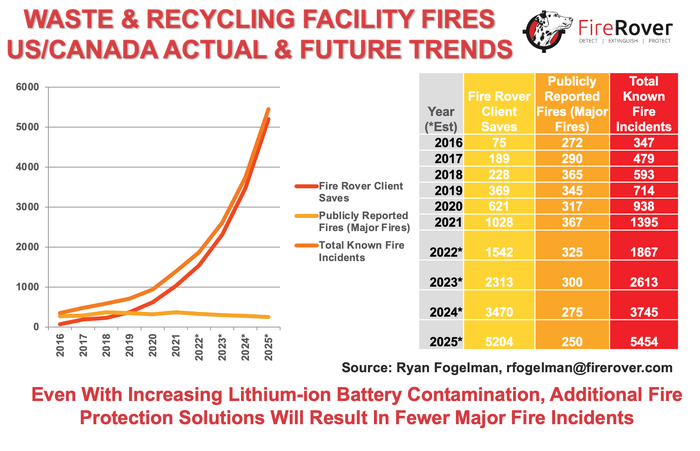
I say this each year, but only time will tell. As we head into 2022, we are installing more of our systems each month, not only in the U.S. but in Canada, Australia, the UK and soon to be France. Our solutions are helping to fight this global problem and changing the way we think about fighting fires.
Additionally, the best practice of “water, water, water,” which is a fire response approach used for hundreds if not thousands of years, is evolving into early detection and immediate response. This puts the waste and recycling industry in a good position to stem the tide over the next couple of years, even with the onslaught of hazards continuing to barrage our waste and recycling streams across the globe.
Getting the Numbers the Waste and Recycling Industry Needs
When I started working for Fire Rover in 2015, I noticed a massive void in the waste and recycling industry: fire incident data. I searched high and low for data on fire incidents at waste and recycling facilities across the U.S. and Canada. I browsed online sources such as Statista and spoke with facility owners and operators, safety and insurance personnel and investors—all without success.
I knew this data was much needed, and I became determined to uncover and share this data, not only to provide the industry with important information but to prove that Fire Rover is a fire suppression system as well as a business continuity solution.
By 2016, I had gathered enough data to begin producing a report called “Reported Waste & Recycling Facility Fires In The US & CAN,” which is now published monthly in Waste360. The report provides updated data each month for the U.S. and Canada; the 2,000-plus actual facility fire number that I use for this data is based on the assumptions from the data that the UK Environment Agency (EA) collected in the table below.
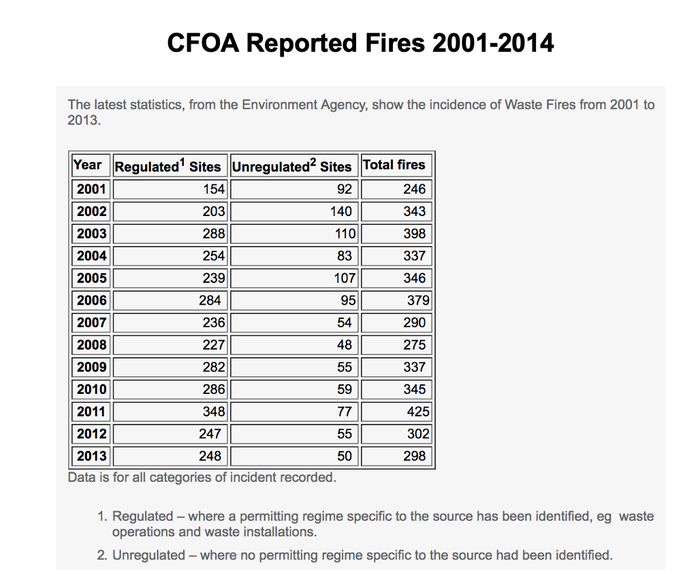
The monthly reports help us identify trends and where we need to make improvements to operate more safely and efficiently. To get a taste of what my data looks like, see the chart below that features the latest data from February 2016 to December 2021:
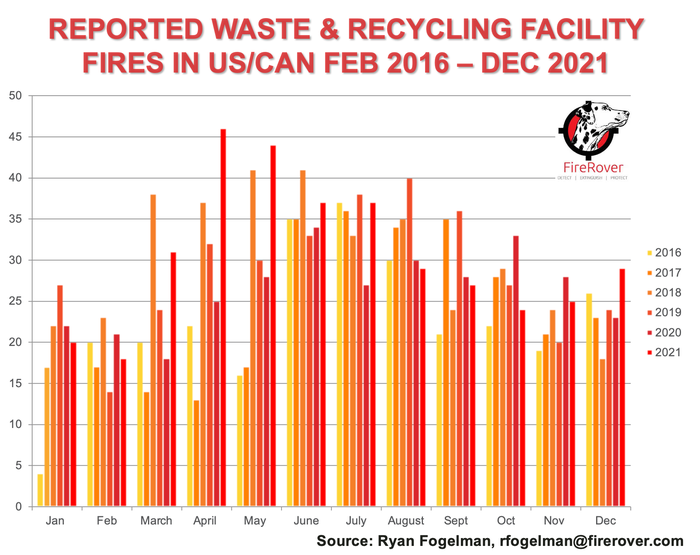
Tracking Reported Fires in the U.S. and Canada
Over the years, I’ve been able to collect important data on reported facility fires. I define “reported facility fires” as any fire that has been reported by the media that occurs at a waste or recycling facility in the U.S. and Canada. Typically, the fires that are reported by the media are larger fires that require fire professionals to arrive on scene and where there are effects that the public can witness.
Some industry professionals suggest that the majority of fires related to waste and recycling are not reported. Others disagree. One thing the industry can agree on, however, is that any fire is one too many.
According to my research, in 2021, waste and recycling facilities in the U.S. and Canada experienced367 fires, two deaths and 37 direct and indirect injuries. These fires ranged from small incidents to complete burnouts and occurred in all types of operations including those for metals, rubber, paper, construction and demolition (C&D) material, plastics, waste, compost, hazardous materials, chemicals and fuels.
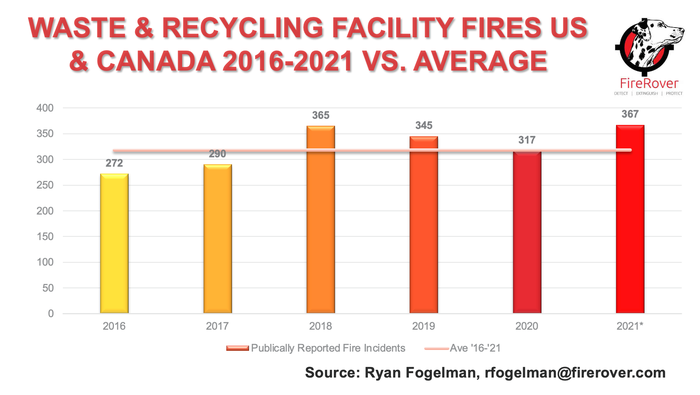
Based on my research, information made available in published news stories and other published reports, I believe we can assume that the number of non-reported fires that occur at waste and recycling operations across the U.S. and Canada is significantly higher.
In a 2016 report entitled “Municipal Solid Waste Management in the U.S.: 2010 & 2013,” for example, the Environmental Research & Education Foundation (EREF) suggested that in 2013, there were 3,913 recycling facilities and 81 waste-to-energy facilities. This means more than 40 percent of facilities across the country experienced a fire incident in the 12 months previous.
More recently, in 2018, the California Products Stewardship Council (CPSC) released survey results from 26 waste facilities located in California. According to the results, 83 percent of the surveyed facilities experienced a fire in the two years previous.
Based on reports such as these, I believe the number of waste and recycling facility fires that occurred in 2021 in the U.S. and Canada is more than 2,200. That’s almost six times the reported number of 367, which includes the Fire Rover reported client incidents I will highlight later in this report.
Conclusion
The information shared so far is only the tip of the iceberg. I am hard at putting my finishing touches on this year’s annual report, which I hope you find valuable. This year’s annual report will release next Tuesday, February 9th, the week before I head to the Global Waste Management Symposium (GWMS), held February 14-17 in Palm Springs, Calif., where I will be presenting my findings along with a panel of distinguished colleagues, as part of the recycling track on Wednesday, February 16 at 1:30 p.m. PT. Click here to learn more about the event and to register. Click here to reserve your advanced copy of this year’s annual waste and recycling facility fires report. I hope your 2022 is off to a great start!
Ryan Fogelman, JD/MBA, is vice president of strategic partnerships for Fire Rover. He is focused on bringing innovative safety solutions to market, and two of his solutions have won the distinguished Edison Innovation Award for Industrial Safety and Consumer Products. He has been compiling and publishing the “Reported Waste & Recycling Facility Fires In The US/CAN” since February 2016 and the “Waste & Recycling Facility Fires Annual Report.” Fogelman speaks regularly on the topic of the scope of fire problems facing the waste and recycling industries, detection solutions, proper fire planning and early-stage fire risk mitigation. Additionally, Fogelman is on the National Fire Protection Association’s Technical Committee for Hazard Materials. (Connect with Ryan on LinkedIn at https://www.linkedin.com/in/ryanjayfogelman or email at [email protected])
About the Author
You May Also Like




.png?width=300&auto=webp&quality=80&disable=upscale)